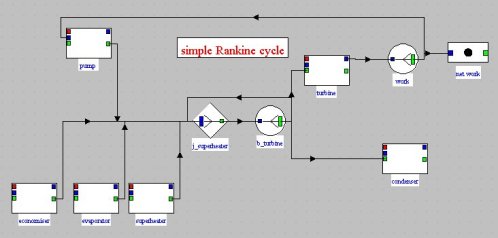Quantitative analysis of cycles, energy and exergy balances
The performance analysis of technologies leads in a conventional way to calculate their energy balances. In addition, particularly when trying to optimize a system, the establishment of its exergy balance is of great interest, as it quantifies the irreversibilities.
Exergy balances of simple cycles
For simple cycles , establish an exergy balance poses no particular problem but needs to be done very carefully as otherwise errors can be committed.
Detailed methodological guidance is provided in the last Chapter of Part 2 of the first edition of the book Energy Systems. The Excel spreadsheet, downloadable from the link below, allows you, with some precautions, to reuse the Thermoptim results files.
In addition, session Diapason S06En , which deals specifically with the establishment of the exergy balances, will guide you through your first steps, and sessions S23En , S28En and S32En will help you develop the exergy balance of a gas turbine, a steam plant or a vapor compression refrigeration machine.
Exergy balances of complex cycles
Even using the spreadsheet above, building the exergy balance of a somewhat complicated system can be difficult in practice, and this for two main reasons:
first, as many changes must be made to the spreadsheet, even though each is relatively simple, their number increases the risk of error;
second, exergy balances being not conservative, there is no simple way to check the consistency of the result.
When the system studied is a bit complex, establishing its exergy balance can be fraught with risk.
Productive structures
It turns out that it is possible to automate the preparation of exergy balances, even for complex systems, by introducing a new type of diagram called by Valero a productive structure. This is a graph allowing us to represent the product or consumption of exergy of the various components in an energy system.
To avoid any misunderstanding, let us specify that it is of course quite possible to do without productive structures when building up exergy balances. We just say that productive structures:
enable a very eloquent graphical representation of exergy flows in energy systems;
can be largely automatically generated when one has a Thermoptim diagram and its thermodynamic settings
facilitate and secure building up exergy balances;
in addition lead to thermo-economic analyses for those who wish to perform.

Productive structure of a steam cycle
Such a productive structure is interpreted as follows: the steam power plant is a machine which receives an external exergy input in the boiler, and by internal recycling, exergy is provided to the pump, which are the two production units in the left of the screen.
This exergy is partly converted into mechanical form in the turbine and partly dissipated in the condenser. The net work is the fraction of mechanical power not recycled.
The productive structure can very well be inferred from the physical sketch (Thermoptim diagram) and thermodynamic parameters (Thermoptim project):
In a first step, we create all productive or dissipative units within strict rules of correspondence. Since it usually takes two icons for each component (the productive unit and the node), we introduce junctions in series and/or of branches in series, which may be grouped in order to simplify the productive structure.;
Therefore, in a second step, pseudo-nodes in series are identified and can be grouped;
In a third step, we end up entering productive structure data, setting exergy balance screens associated to each productive or dissipative unit. For example, the blue exergy inputs (mechanical power) are not connected at this stage, as temperatures of outside sources with which heat-exergy is exchanged are not defined.
It is then possible to automatically generate the exergy balance of the cycle.

Exergy balance for the steam cycle obtained from the productive structure
You will find some supplements on production structures at the end of part 2 of the book Energy Systems and in the reference below.
Remark
Thermoptim versions that allow you to edit the productive structures and to build up exergy balances are versions 2.6 and 2.8.
Reference
Valero, A., Serra, L., Uche, J., Fundamentals of thermoeconomics, lectures 1-3, Euro summer course on sustainable assesment of clean air technologies, downloadable from the website of the CIRCE .
